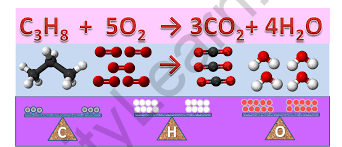Table of Contents

Markovnikov’s rule is an empirical rule used to predict the regioselectivity of alkenes and alkynes in electrophilic addition reactions. We must discuss the mechanism of Markovnikov’s rule while keeping the goal in mind. According to Markovnikov’s rule, when a preotic acid HX is added to an asymmetric alkene, the acid hydrogen (H) attaches to the carbon with more hydrogen substituents. Let’s use a simple example to demonstrate Markovnikov’s rule.
When an asymmetrically substituted alkene is treated with a preotic acid HC (X = Cl, Br, I), acidic hydrogen is added to the less substituted carbon atom of the double bond. To put it another way, hydrogen is added to the carbon atom with the most hydrogen atoms, whereas halide is added to the carbon atom with the fewest hydrogen atoms. The production of a carbocation in the initial phase of the reaction, when H is added to the alkene, provides the driving force behind the reaction. Due to processes such as induction and hyperconjugation, the most stable carbocation is created when H is added to carbon with a higher number of hydrogen atoms already attached, whereas Br added to less hydrogen-rich carbon produces the primary product.
In addition to Br to carbon with more hydrogen attached, less stable carbocation (H added to less hydrogen-rich carbon) is present in tiny amounts, creating minor products.
Markovnikov reactions –
1. Butene reacts with hydrobromic acid.
2. Propene’s reaction with HI –
3. In addition to aromatic alkenes, Markovnikov’s rule is used.
4. Propone-HBr reaction
Reasons for Markovnikov’s reaction
Acidic hydrogen ion or proton is electrophilically added to an alkene, a carbocation is created. It’s a more stable kind of carbocation. As we all know, the most stable carbocation has the positive charge carried by the carbon with the greatest alkyl substituents. This is why the bulk of products involves combining a halide with carbon that has a larger amount of alkyl groups.
Examples
1. Alkene Hydration
An electrophilic addition reaction happens when alkenes are dealt with with certain aqueous acids (most often sulfuric acid), generating alcohol as a result. The regioselectivity of such reactions may be predicted using Markovnikov’s rule. As a result, Markovnikov reactions are named after them.
In the hydration of alkenes, the H+ ion acts as an electrophile, attacking the alkene to form a carbocation intermediate (the intermediate with greater stability is protonated). The carbocation is subsequently attacked by nucleophilic ally by water molecules, creating a xenium ion, which is then deprotonated to yield the required alcohol product.
2. Hydroboration and Oxidation of Alkenes
Alcohol is produced when alkenes are treated with borane (BH3) in the presence of hydrogen peroxide or sodium hydroxide. The boron atom functions as an electrophile in this electrophilic addition process. This reaction is classified as an anti-Markovnikov reaction since it contradicts Markovnikov’s rule.
Anti Markovnikov’s Rule
The Anti-Markovnikov rule describes radiochemistry when a substituent is linked to a less substituted carbon rather than a more substituted carbon. Because carbon cations normally formed during alkene or alkyne reactions favour the more substituted carbon, this technique is relatively uncommon. Because substituted carbocation allows for more hyperconjugation and induction, the carbocation becomes more stable.
Only HBr may perform radical haloalkane addition under Anti-Markovnikov, and Hydrogen Peroxide must be present (H2O2). Hydrogen peroxide is required for this approach since it is the chemical that starts the chain reaction in the initiation step. HI and HCl cannot be used in radical reactions, as stated in Chem 118A, because one of the radical reaction stages is: Initiation is Endothermic, which implies the reaction is unfavourable.
Things to keep in mind
Markovnikov’s rule states that hydrogen should be added to the carbon with the most hydrogens, and halide should be put to the carbon with the fewest hydrogens.
When an acidic hydrogen ion or proton is electrophilically added to an alkene, a carbocation is created.
The positive charge is borne by the carbon with the greatest alkyl substituents in the most stable carbocation.
Alcohol is produced when alkenes are treated with borane (BH3) in the presence of hydrogen peroxide or sodium hydroxide.
The Anti-Markovnikov rule describes radiochemistry when a substituent is linked to a less substituted carbon rather than a more substituted carbon.
FAQs
What is the practical application of Markovnikov's rule?
Markovnikov's rule has a number of practical uses. Halohydrin production (in alcohol and water), Oxymercuration and Demercuration, and Acid-catalyzed hydration are a few of them. These are the laboratory applications of Markovnikov's rule, which are employed in a wide range of chemical processes.
What is the Markovnikov rule?
For the prediction of the main product in the electrophilic addition of unsymmetrical alkenes, Markovnikov suggested the Markovnikov rule. The negative component of the additional molecule is connected to the carbon atom with the least amount of hydrogen atoms, according to the Markovnikov rule.
What is the purpose of Markovnikov's Rule?
The protonation of the alkene by the preotic acid results in the formation of a carbocation. The most stable carbocation is one in which the positive charge is borne by the carbon with the greatest alkyl substituents. As a result, the halide is added to carbon with fewer hydrogen substituents, which makes up the majority of the product.







